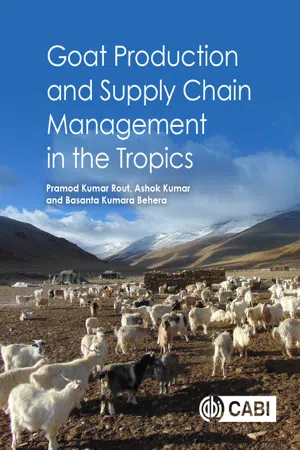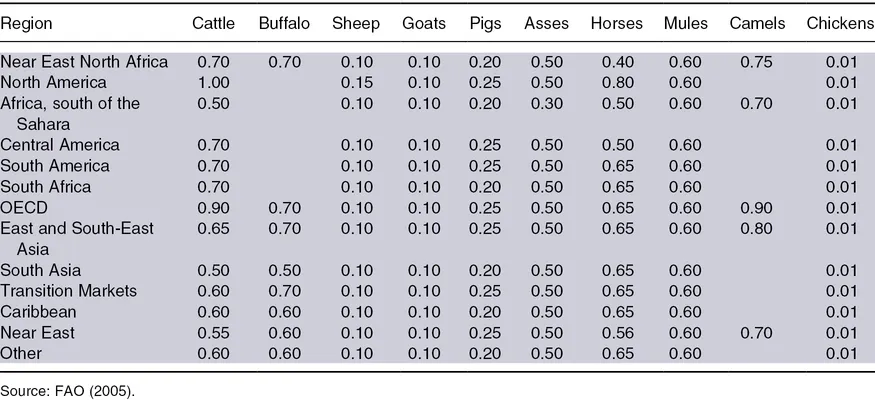
Goat Production and Supply Chain Management in the Tropics
- English
- ePUB (mobile friendly)
- Available on iOS & Android
Goat Production and Supply Chain Management in the Tropics
About this book
This book is a practical manual for goat production systems covering: breeding and selection, feeding based on available crops and resources, and targeted preventative health care for increased productivity and income. It outlines best practice and strategies for setting up a farm, overcoming challenges, increasing milk and meat quality, obtaining sustainability, reducing environmental pollution, optimising climatic conditions and tapping into local know-how. In addition, the book details developing region-specific data for effective decision making and better management, as well as how to run a developmental project to empower stake holders for higher production, support innovation, and analyse the supply chain for better product quality and marketing.
Frequently asked questions
- Essential is ideal for learners and professionals who enjoy exploring a wide range of subjects. Access the Essential Library with 800,000+ trusted titles and best-sellers across business, personal growth, and the humanities. Includes unlimited reading time and Standard Read Aloud voice.
- Complete: Perfect for advanced learners and researchers needing full, unrestricted access. Unlock 1.4M+ books across hundreds of subjects, including academic and specialized titles. The Complete Plan also includes advanced features like Premium Read Aloud and Research Assistant.
Please note we cannot support devices running on iOS 13 and Android 7 or earlier. Learn more about using the app.
Information
1.1 Tropical Livestock Units
Comparing Livestock Species
1.1.1 Livestock unit calculations

Type of animal | Age group | Coefficient |
Bovine | <1 year of age | 0.4 |
>1 year of age and <2 years of age | 0.7 | |
Male >2 years of age | 1.0 | |
Heifers >2 years of age | 0.8 | |
Dairy cow | 1.0 | |
Other cows (>2 years of age) | 0.8 | |
Sheep & Goat | 0.10 | |
Equine | 0.80 | |
Pig | Piglet body weight <20 kg | 0.027 |
Breeding sows >50 kg | 0.50 | |
Other Pigs | 0.30 | |
Poultry | Broilers | 0.007 |
Laying Hens | 0.014 | |
Ostriches | 0.350 | |
Other poultry | 0.0350 | |
Rabbit | 0.020 |
1.1.2 Animal unit coefficient
Type of animal | Animal unit coefficient |
A Dairy Cattle | |
Mature cow over 1000 lb (450 kg) | 1.4 |
Mature cow under 1000 lb (450 kg) | 1.0 |
Heifer | 0.7 |
Calf | 0.2 |
B Beef Cattle | |
Slaughter steer or stock cow | 1.0 |
Feeder cattle or heifer | 0.7 |
Cow and calf pair | 1.2 |
Calf | 0.2 |
C Swine | |
Over 300 lb (136 kg) | 0.4 |
Between 55 and 300 lb (25–136 kg) | 0.3 |
Under 55 lb (25 kg) | 0.05 |
D Horse | 1.0 |
E Sheep and lambs/goats | 0.1 |
F Chickens | |
Laying hen or broiler (liquid manure system) | 0.033 |
Chicken over 5 lb (dry manure system) | 0.005 |
Chicken under 5 lb (dry m... | |
Table of contents
- Cover
- Half Title
- Title
- Copyright
- Contents
- List of Tables
- List of Figures
- About the Book
- Preface
- Acknowledgements
- 1 Goat Production Challenges to Food Security
- 2 Prospects and Strategies of Genetic Resources
- 3 Reproduction Management
- 4 Nutritional Management
- 5 Health Management
- 6 Herd Management
- 7 Production System Characterization and Development
- 8 Goat Products Supply Chains
- Index
- Cabi
- Back